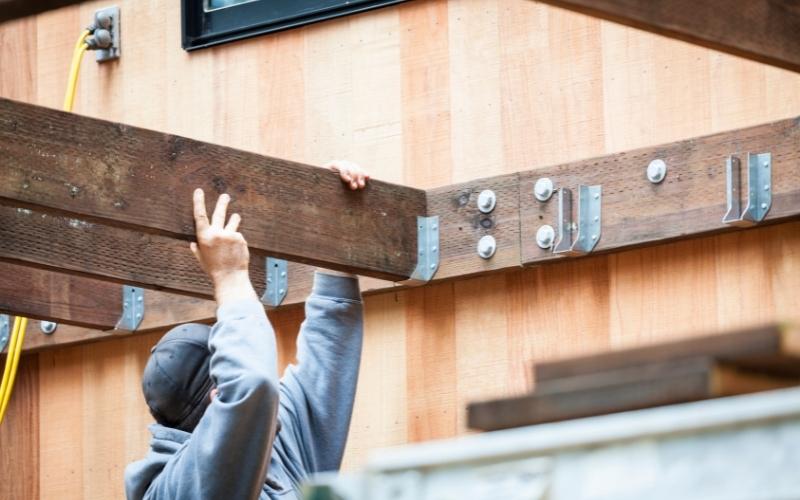Have you ever looked at a building and wondered, “What keeps this entire thing standing?” You’re not alone! The secret lies in bearer construction, a fascinating yet often overlooked part of creating safe and sturdy homes, offices, and buildings we use every day. Imagine a building without a strong foundation or structural support. It would be like trying to stack Jenga blocks on a soft cushion. Disaster, right? That’s why bearer construction plays such an essential role.
What Is Bearer Construction?
Simply put, bearer construction involves the use of bearers to provide strength and balance to a building. Think of bearers as the backbones of the structure. They are horizontal pieces, like beams, that help hold up floors, walls, and even roofs. Without them, there’d be no sturdy platform for everything else to rest on.
But here’s where it gets cool. Bearers don’t work alone! They team up with joists, which are like little helpers. Together, this dynamic duo forms the base for a building’s floor system. Floorboards are then laid atop this strong support, giving you the surface you walk on every day. Neat, huh?
Why Do We Need Bearers?
The main job of bearer construction is to handle load distribution. Load what, you ask? Picture the weight of furniture, people dancing at a wedding, or even heavy equipment in a workshop. That’s called the “load.” Bearers spread that weight evenly across the building’s foundation, making it less likely for the structure to sag or collapse. It’s like having dozens of weightlifters evenly balancing a heavy barbell.
Whether we’re talking about timber construction or steel bearers, the concept stays the same. These materials work wonders by giving us something rock-solid to rely on. It’s the ultimate superhero of reliability but for buildings.
How Does It All Work?
To understand bearer construction, it’s crucial to think about the overall design. Here’s a step-by-step rundown:
- The building foundation is prepared. This is the very base, where everything begins.
- Foundation stability is a big focus here. Strong soil? Check. Reliable materials? Double-check.
- Next, joist spacing is planned out. This is where those little helper beams, or joists, come into play. But they can’t be randomly placed! Proper joist installation ensures there’s no wobbling or creaking floors.
- Finally, the load-bearing structure is built, using materials like wood for timber construction or metal for steel bearers. This guarantees that all parts of the building stay tightly connected and aligned.
When done by experts following construction guidelines and modern engineering standards, the results are amazing. And isn’t it comforting to know so much effort goes into your home’s safety?
Fun Facts About Bearer Construction
Did you know that the strength of bearers can be traced back to ancient times? Even the grand Roman aqueducts used forms of load-bearing structure techniques! Over time, we’ve swapped out ancient materials like mud bricks for modern ones like steel or treated wood. Now, our construction materials are stronger than ever.
Another fun fact? The spacing between bearers and joists (a.k.a. joist spacing) must be incredibly precise. Too much distance? The floor becomes weak. Too little space? It’s a waste of materials. Builders have to calculate this using special engineering requirements down to the millimeter!
Where Is Bearer Construction Needed?
Pretty much everywhere you see a building! Residential construction, offices, schools, bridges, and even high-rises rely on this technique. The materials might change depending on the kind of project (hello, timber specifications), but the goal remains the same: ensuring strength and stability.
Even during building inspections, experts closely examine bearers, joists, and the foundation types. These inspections can uncover small cracks, shifts in foundation stability, or even signs of wear before they become major issues. It’s like a check-up for your home’s health!
Keeping Homes Safe
We all want our homes to be a safe haven. And bearer construction helps make that happen. Builders follow strict construction standards, building regulations, and building codes to ensure structures can handle load capacity over time. From earthquakes to everyday wear and tear, the right foundation techniques make a world of difference.
Local experts even offer inspection services and foundation assessments to check if everything is holding up as it should. If something’s off, they’ll recommend repairs or adjustments using the right construction methods. It’s all about keeping you safe and sound.
Types of Bearers
Not all bearers are built the same! Here are two popular options:
1. Timber Bearers
Timber construction is lightweight but still super durable when treated right. These are common in residential construction for homes with wooden floors. Whether it’s pine or hardwood, material selection is key for long-lasting results.
2. Steel Bearers
For heavy projects, like industrial factories, steel bearers are the way to go. These can handle more weight and are highly resistant to bending or cracking. They’re like the Arnold Schwarzenegger of building materials.
What Happens If You Skip Bearer Construction?
Skipping bearer construction or cutting corners could lead to disaster. Imagine your floor suddenly collapsing because the weight distribution wasn’t even. Yikes! This is why following the rules outlined in construction guidelines and engineering standards is non-negotiable.
Improper load-bearing wall construction or ignoring foundation techniques can also compromise your structural integrity. Plus, without proper foundation assessment, small issues can turn into costly repairs down the road. No home or building owner wants that, right?
Bringing It All Together
At this point, you’re practically a construction expert! You now know that bearer construction isn’t just about beams and bolts. It’s about creating safe spaces where people live, work, laugh, and grow. By distributing weight, aligning joist spacing, and using dependable construction materials, this type of building sets the stage for stability and safety.
The next time you’re walking across a sturdy wood floor or marveling at a towering skyscraper, remember to thank the unsung hero of the story: bearer construction. Strong, reliable, and carefully designed to keep our world standing tall!trial applications.

